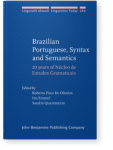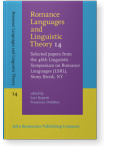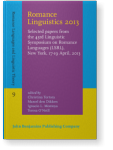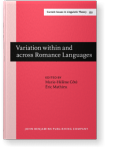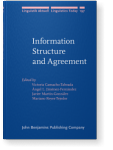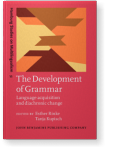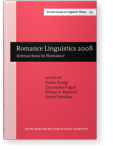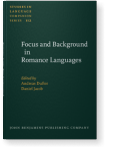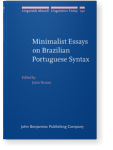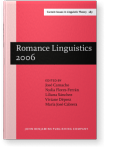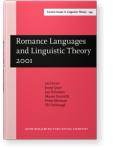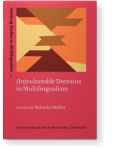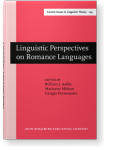Mary Aizawa Kato
List of John Benjamins publications for which Mary Aizawa Kato plays a role.
2020 Chapter 5. Wh -questions in Brazilian Portuguese and Quebec French Brazilian Portuguese, Syntax and Semantics: 20 years of Núcleo de Estudos Gramaticais, Pires De Oliveira, Roberta, Ina Emmel and Sandra Quarezemin (eds.), pp. 135–150 | Chapter
In this paper I propose (a) that Brazilian Portuguese and Quebec French underwent a very similar diachronic development of wh-questions; (b) that the great structural change in both languages was the loss of long wh-movement with the appearance of a short wh-movement to a position of Focus… read more
2018 Chapter 8. Morphological doublets in Brazilian Portuguese wh-constructions Romance Languages and Linguistic Theory 14: Selected papers from the 46th Linguistic Symposium on Romance Languages (LSRL), Stony Brook, NY, Repetti, Lori and Francisco Ordóñez (eds.), pp. 135–152 | Chapter
This chapter contains an overview of diachronic and synchronic studies on Brazilian Portuguese wh-questions, and discusses the intriguing problem of apparent syntactic doublets, or optionality, in this domain. However, a careful examination of the diachronic order in which these patterns appear,… read more
2016 Affirmative polar replies in Brazilian Portuguese Romance Linguistics 2013: Selected papers from the 43rd Linguistic Symposium on Romance Languages (LSRL), New York, 17-19 April, 2013, Tortora, Christina, Marcel den Dikken, Ignacio L. Montoya and Teresa O'Neill (eds.), pp. 195–212 | Article
This article analyzes affirmative polar replies in Brazilian and European Portuguese (BP/EP), which may consist of just the inflected verb or some polar item. These polar replies have been analyzed as instances of null subjects and VP-Ellipsis. This analysis is untenable for BP, as this variety has… read more
2014 The role of the copula in the diachronic development of focus constructions
in Portuguese Variation within and across Romance Languages: Selected papers from the 41st Linguistic Symposium on Romance Languages (LSRL), Ottawa, 5–7 May 2011, Côté, Marie-Hélène and Eric Mathieu (eds.), pp. 297–314 | Article
Old and Classic Portuguese had two positions for contrastive focus: one at the sentence initial position, followed by the verb, a ‘V2’ sort of pattern (XPVS), and one at the sentence final position, constituting the Romance post-verbal subject (V(XP)S). This paper analyzes the role of the copula in… read more
2013 Deriving “wh-in-situ” through movement in Brazilian Portuguese Information Structure and Agreement, Camacho-Taboada, Victoria, Ángel L. Jiménez-Fernández, Javier Martín-González and Mariano Reyes-Tejedor (eds.), pp. 175–192 | Article
While languages like English have both dislocated and in-situ wh-phrases, but assign different status to the two types of question – ordinary questions or echo questions -, others, like French, take them as possible syntactic variants for ordinary questions. Moreover, the in-situ wh-question in… read more
2011 Acquisition in the context of language change: The case of Brazilian Portuguese null subjects The Development of Grammar: Language acquisition and diachronic change, Rinke, Esther and Tanja Kupisch (eds.), pp. 309–330 | Article
Brazilian Portuguese (BP) has been described as having undergone a selective loss of null subjects, with the categorical maintenance of null expletives, and a limited possibility of referential null subjects in the third person. In the I-language of most literate adults, a range of referential null… read more
2010 Optional prepositions in Brazilian Portuguese Romance Linguistics 2008: Interactions in Romance, Arregi, Karlos, Zsuzsanna Fagyal, Silvina Montrul and Annie Tremblay (eds.), pp. 171–184 | Article
This paper discusses the phenomenon of preposition optionallity in Brazilian Portuguese (BP), starting from Bouchard’s (1981) observation that the preposition of a strictly subcategorized PP complement in French can be absent in the “chopping” type of relativization, though the same sort of… read more
2009 Cleft sentences from Old Portuguese to Modern Portuguese Focus and Background in Romance Languages, Dufter, Andreas and Daniel Jacob (eds.), pp. 123–154 | Article
2009 Chapter 5. A Uniform raising analysis for standard and nonstandard relative clauses in Brazilian Portuguese Minimalist Essays on Brazilian Portuguese Syntax, Nunes, Jairo (ed.), pp. 93–120 | Article
Based on Kayne’s (1994) analysis of relative clauses, this paper proposes a uniform account of the three types of relative clauses found in Brazilian Portuguese: the standard version (with pied-piping), the resumptive version with an overt pronoun, and the PP-chopping version, where the relativized… read more
2007 Topicalization in European and Brazilian Portuguese Romance Linguistics 2006: Selected papers from the 36th Linguistic Symposium on Romance Languages (LSRL), New Brunswick, March-April 2006, Camacho, José, Nydia Flores-Ferrán, Liliana Sánchez, Viviane Déprez and María José Cabrera (eds.), pp. 205–218 | Article
2003 Null Objects and VP Ellipsis in European and Brazilian Portuguese Romance Languages and Linguistic Theory 2001: Selected papers from 'Going Romance', Amsterdam, 6–8 December 2001, Quer, Josep, Jan Schroten, Mauro Scorretti, Petra Sleeman and Els Verheugd-Daatzelaar (eds.), pp. 131–153 | Article
2003 Child L2 acquisition: An insider account (In)vulnerable Domains in Multilingualism, Müller, Natascha (ed.), pp. 271–293 | Article
1993 The distribution of pronouns and Null elements in object position in Brazilian Portuguese Linguistic Perspectives on Romance Languages: Selected Papers from the XXI Linguistic Symposium on Romance Languages, Santa Barbara, February 21–24, 1991, Ashby, William J., Marianne Mithun and Giorgio Perissinotto (eds.), pp. 225–236 | Article
